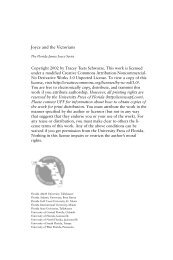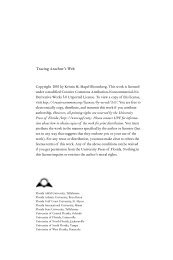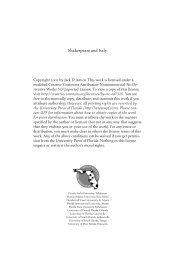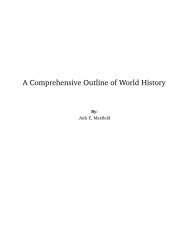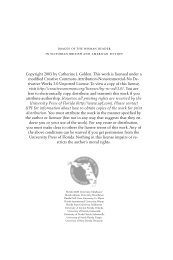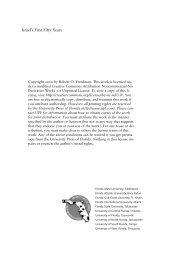Bernard Shaw's Remarkable Religion: A Faith That Fits the Facts
Bernard Shaw's Remarkable Religion: A Faith That Fits the Facts
Bernard Shaw's Remarkable Religion: A Faith That Fits the Facts
Create successful ePaper yourself
Turn your PDF publications into a flip-book with our unique Google optimized e-Paper software.
92 <strong>Bernard</strong> Shaw’s <strong>Remarkable</strong> <strong>Religion</strong><br />
mechanism, which had been virtually an end in itself, becomes in Ibsen’s<br />
hands a metaphor for <strong>the</strong> “whited sepulcher,” <strong>the</strong> facade of artificial respectability<br />
hiding a diseased society. In o<strong>the</strong>r words, well-made construction<br />
in its traditional manifestation represented <strong>the</strong> successful repression<br />
of disorder by <strong>the</strong> restraints of bourgeois respectability, while Ibsen’s subversion<br />
of it exposed it as a middle-class mask of respectability covering a<br />
foul disease.<br />
In <strong>the</strong> running dispute between Archer and Shaw about <strong>the</strong> value of<br />
“construction” in drama, Archer seems most annoyed by Shaw’s insistence<br />
that Ibsen (to say nothing of Shakespeare, Sophocles, and Molière)<br />
was in <strong>the</strong> Shavian camp ra<strong>the</strong>r than that of <strong>the</strong> constructors. For Archer<br />
<strong>the</strong> difference between “good” (that is, “crafted”) drama and <strong>the</strong> “amorphous”<br />
kind Shaw produced was <strong>the</strong> difference between a cat and a jellyfish;<br />
Shaw responded that <strong>the</strong> difference was that between a dead cat and a<br />
live one (Collected Letters 3:836–37). Shaw fully recognized Ibsen’s craft<br />
(Collected Letters 3:833); he merely insisted that what is important in<br />
Ibsen resembles Shaw more than Sardou. “Ibsen’s method was <strong>the</strong> vital<br />
method, not <strong>the</strong> mechanical one” (Collected Letters 3:837). The portrayal<br />
of real people coming to grips with real problems, not <strong>the</strong> cleverness of plot<br />
assemblage, makes Ibsen’s plays live. The structure that matters is that<br />
produced by <strong>the</strong> natural unfolding of <strong>the</strong> action.<br />
Uncertain Dramatic Beginnings: Widowers’ Houses<br />
Shaw’s technique differs from Ibsen’s to <strong>the</strong> extent that his point of view is<br />
different. Where Ibsen, <strong>the</strong> “pessimist” by “old habit” (Collected Letters<br />
1:427), contrasts <strong>the</strong> painted mask with <strong>the</strong> decayed face, Shaw’s more<br />
positive view is that <strong>the</strong> mask is unnecessary if only we can learn to respect<br />
reality: expose <strong>the</strong> pallid face to fresh air and sunshine and it will become<br />
robust and healthy. Shaw’s initial efforts as a playwright were in <strong>the</strong> vein<br />
of Ibsen and Zola to <strong>the</strong> extent that he wished to expose social evils so that<br />
<strong>the</strong>y might be corrected. The difference in his way of seeing those evils<br />
necessitated a different way of presenting <strong>the</strong>m, a new dramatic technique<br />
that was not easy to develop. On <strong>the</strong> one hand, it was simple for Shaw, with<br />
his realist’s vision, to see that illusionism is irrelevant to naturalism and<br />
that Zolaism could become a superstition when it came to believe that ugliness<br />
is more real than beauty and police reporting more natural than<br />
drawing-room conversation. On <strong>the</strong> o<strong>the</strong>r hand, it was more difficult to<br />
find <strong>the</strong> aes<strong>the</strong>tic means to embody his own version of <strong>the</strong> truth. From a



